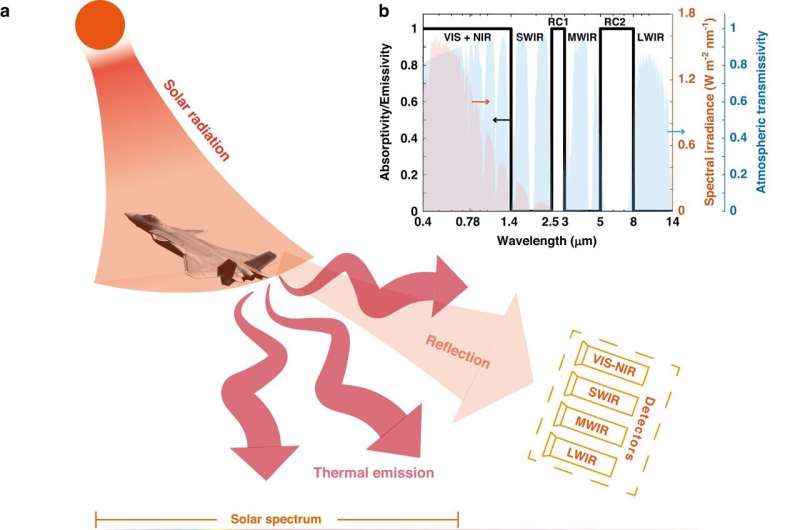This article has been reviewed according to Science X's editorial process and policies. Editors have highlighted the following attributes while ensuring the content's credibility:
fact-checked
trusted source
proofread
Whole-infrared-band camouflage with dual-band radiative heat dissipation

Camouflage refers to the ability to reduce the signal captured by detectors, thereby improving survival rates. However, the combination of detectors operating in multiple spectral bands poses a significant challenge, necessitating the development of multiband camouflage technologies. Besides, camouflage usually conflicts with radiative heat dissipation demands, which have significant contributions to the thermal management of objects.
Objects typically betray their presence through two types of signals: reflected signals from external light sources and thermal emission signals from the objects themselves. On the one hand, objects in nature are illuminated by external light sources, among which solar radiance is the most significant. Solar radiance emits its energy mainly in the spectral range of 0.15–4 μm and plays a crucial role in the visible (VIS, 400–780 nm), near-infrared (NIR, 0.78–1.4 μm), and short-wave infrared (SWIR, 1.4–2.5 μm) detection bands.
On the other hand, objects radiate energy through thermal emission, which can be detected by detectors that work in atmospheric transmission windows (mid-wave infrared (MWIR, 3–5 μm) and long-wave infrared (LWIR, 8–14 μm)). With temperature rising, the peak wavelength of thermal emission shifts to the short-wave direction, making the radiative signal in the SWIR band non-negligible.
In a new paper published in Light: Science & Applications, a team of scientists, led by Professor Qiang Li from State Key Laboratory of Modern Optical Instrumentation, College of Optical Science and Engineering, Zhejiang University, China, and co-workers have developed a whole-infrared-band camouflage device, which is compatible with radiative heat dissipation in two undetected bands (2.5–3 μm and 5–8 μm). Based on the understanding of the signal sources, they have proposed the spectral features of camouflage devices:
- In the SWIR band, low emissivity has a wider scope of application. The highest irradiance of sunshine is similar to that of a 330° C blackbody. However, in practical scenarios, where solar irradiance is generally lower than its highest level, inhibiting thermal emission makes greater contributions to reducing total signal intensity.
- In the MWIR and LWIR bands, low emissivity is more suitable as thermal emission usually dominates the detected signal and the intensity of sunshine is weak enough to be negligible.
- In the VIS and NIR bands, low reflectivity is preferable since the predominant source of detected signal is reflected solar radiance and thermal emission is generally insignificant.
The Al2O3/Ge/Al2O3/Ge/ZnS/GST/Ni multilayer structure is employed to modulate the ultra-broad spectrum from the visible to the LWIR range. The unique architecture of this structure allows it to cater to the varying demands of the entire infrared range and the visible range, while concurrently achieving efficient radiative heat dissipation within two undetected bands.
Appearing gray-blue, the fabricated sample exhibits low average reflectivity in the VIS/NIR bands (0.129/0.281). When heating up to 200° C, the radiative (apparent) temperatures of the sample under the MWIR/LWIR cameras are merely 86.3° C/94.7° C. Compared to the reference blackbody, the signal intensity of the sample is 39.3% lower under the SWIR camera. Particularly, the SWIR camouflage performance is demonstrated under solar radiance. At higher temperatures, the sample exhibits smaller signal intensity than the Cr reference in all observing directions. While at lower temperatures, the sample maintains the edge except in the specular reflection direction of solar radiance.
The efficacy of radiative heat dissipation is demonstrated by putting the sample and the Cr reference subjected to the same input electrical heating power. At 20 W input power (equivalent to a power density of 2000 Wm−2), the surface temperature of the sample is 174.5° C, which is 14.4° C lower than that of the Cr reference.
These lower surface temperatures help to reduce thermal load and improve the performance of MWIR and LWIR camouflage.
"This work provides a comprehensive guideline for developing camouflage technologies compatible with radiative heat dissipation, against complicated signal sources and multispectral detective technologies," the scientists noted.
"This device for whole-infrared-band camouflage can facilitate applications that require sophisticated spectrum manipulation and stimulate innovative avenues for modern thermal management technologies and contribute to an energy-efficient future," they say.
More information: Bing Qin et al, Whole-infrared-band camouflage with dual-band radiative heat dissipation, Light: Science & Applications (2023). DOI: 10.1038/s41377-023-01287-z
Provided by Chinese Academy of Sciences




















